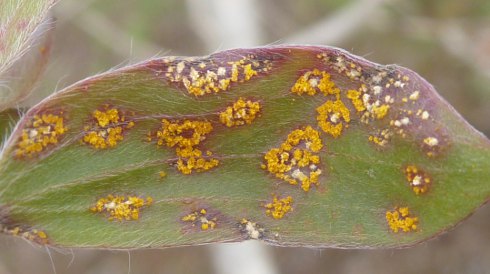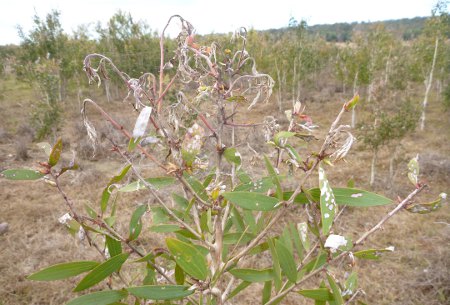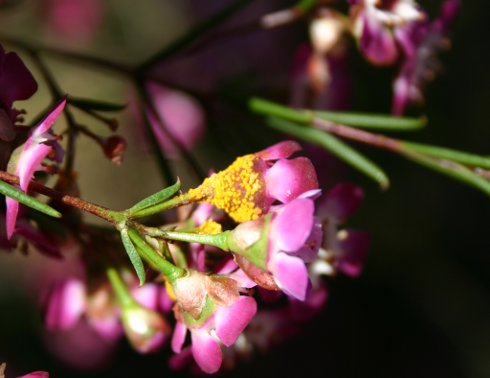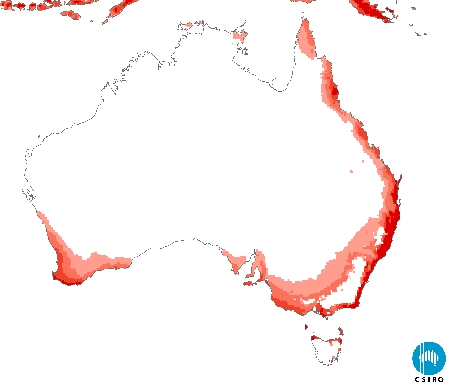
|
Published: 29 August 2011
Myrtle rust: how big a threat to native plants?
What happens when a plant pathogen invades a new continent brimming with potential victims? Australia is set to find out, as myrtle rust spreads within the country’s dominant plant family – the Myrtaceae.

|
|
Leaf of broad-leaved paperbark on NSW’s north coast infected with myrtle rust. Credit: Angus Carnegie.
|
In 1973, a rust disease killed swathes of young flooded gums (Eucalyptus grandis) in plantations and nurseries in Brazil. A few plant pathologists started worrying about what would happen if this fungus or its relatives reached Australia, home of the gum tree.
The infection was caused by guava rust (Puccinia psidii), so named because it was first described in Brazil in 1884 on guavas (Psidium guajava) – members of the same plant family as eucalypts. Now also known as eucalyptus rust, it infects 28 Myrtaceae species native to South and Central America, usually with mild impacts.1
The pathologists’ foreboding was reinforced when the rust turned up in Florida in 1977, severely damaging broad-leaved paperbarks (Melaleuca quinquenervia), an Australian tree that is weedy in that region.2
In a 1996 CSIRO review, Australian mycologist John Walker predicted that the rust would be an ‘ecological disaster’ if it entered Australia, where about 10 per cent of flora are Myrtaceae.3
In April 2010, unusual leaf blotches on plants in a New South Wales nursery signalled the pathogen’s arrival. Out checking eucalypt plantations for disease, Dr Angus Carnegie – a forest pathologist with the NSW Government – received a message to drop everything.
‘This was the disease we’d been waiting for but hoping would never arrive,’ Dr Carnegie says.
With eradication having failed, Dr Carnegie is now monitoring the rust’s spread through the Australian bush. More than a hundred species have been infected so far, in a zone stretching about 1000 kilometres from Wollongong to Gympie.4
Although fungal experts agree that the rust invading Australia is a member of the eucalyptus/guava rust complex (Puccinia psidii), it has been officially designated a separate species called myrtle rust (Uredo rangelii). The Australian invader differs from eucalyptus rust in the structure of one of its spore types, but no genetic differences have been found.5 The Australian government is funding work to resolve relationships within the eucalyptus rust complex.
Different members of the complex infect overlapping suites of Myrtaceae species with varying severity.
CSIRO plant pathologist Dr Louise Morin says while she has seen rusts that cause more damage, myrtle rust is ‘remarkable for its wide host range’. Most rusts infect only one or a few species – yet of the 118 Myrtaceae taxa Dr Morin has laboratory tested, only 11 were immune to myrtle rust. The rest – about 90 per cent, including representatives from 13 of 15 tribes in Australia – proved susceptible to some degree.6
However, adds Dr Morin, this wide host range ‘may not be realised in the field’. Although most of the 2200 Australian Myrtaceae species may be susceptible, the disease can develop only in actively growing shoots, in the presence of sufficient infective spores and conducive climatic conditions.
CSIRO ecologist Dr Darren Kriticos has used the rust’s overseas distribution and known temperature and moisture requirements to map the areas at risk. The rust requires at least three hours of leaf moisture to germinate, and grows best between 14 and 25°C. Areas east of the Great Divide are most at risk.
‘Future climate change will extend the areas at risk in southern Australia, significantly increasing the risk to Tasmania,’ says Dr Kriticos.
Degrees of damage
With a favourable climate and a plethora of hosts, myrtle rust should thrive in Australia. But whether the rust is dire for plants and ecosystems will depend on the severity of infection and extent of resistance.
Plant pathogens can be typified as killers (causing rapid host death), castrators (attacking reproductive structures) or debilitators (causing damage that reduces plant fitness).7
Eucalyptus rusts are primarily debilitators – stunting plant growth, compromising reproduction and rendering them vulnerable to infection by other pathogens. They attack growing tissues such as young leaves and stems, and sometimes flower buds and fruits. Seedlings often die, but mature plants survive, unless they are infected year after year and depleted of energy reserves.
‘It’s only been a few months, but already we have seen severe impacts on a few species, including shoot death, fruit collapse and seedling death, and impacts on stands across many localities,’ Dr Carnegie says.
Of host species showing moderate to severe infection, some are rare (the endangered Rhodamnia angustifolia), some are ecologically important (broad-leaved paperbarks, the nectar of which feeds lots of wildlife) and some are economically valuable (crops of aniseed myrtle and lemon myrtle).

|
|
Regenerating broad-leaved paperbark on NSW’s north coast infected with myrtle rust, July 2011. Credit: Angus Carnegie.
|
Surprisingly, although many eucalypts have proved susceptible in the laboratory, they’ve been hardly affected in the wild. But, cautions Dr Carnegie, ‘it’s early days yet.’
The rust’s greatest impact may be on plant succession – for particular species and for landscapes. Queensland government forest pathologist, Dr Geoff Pegg, warns that the rust could retard regeneration of key Myrtaceae species and reduce their ability to compete, resulting in dramatic changes in plant composition over large areas.
‘For example, Rhodomyrtus psidioides (native guava) has an important successional role in rainforest regeneration and is being badly affected by the rust,’ Dr Pegg says.
Recent cooler, drier conditions have not halted its spread.
‘We thought it would slow much more than it has, but it continues to reproduce and infect new hosts,’ he adds.
‘It seems there is no seasonal respite for susceptible plants, and the maintenance of infectious spores in the environment means we could see increased disease severity and spread with the return of even more favourable conditions.’

|
|
Flowers of Geraldton wax in Brisbane infected by myrtle rust. Geraldton wax is endemic to Western Australia but widely grown in gardens and for the cut flower trade. Credit: Geoff Pegg.
|
The potential for resistance
There is some hopeful news. In about two-thirds of the 118 taxa tested by CSIRO, only some individuals became infected.
‘This suggests that there could be some level of resistance present in many species,’ says Dr Morin.
Brazilian plantations now use flooded gum clones containing resistance genes. CSIRO molecular biologist Dr Simon Southerton will investigate the potential for breeding resistant varieties of another important plantation tree, blue gum (Eucalyptus globulus). He suspects the same major resistance gene is widespread among eucalypts, and could be in other Myrtaceae.
‘It probably evolved in response to some other common pathogen in Australia,’ he says.
Pathogens can outpace resistance-breeding programs through sexual recombination or mutation. Fortunately for Australian Myrtaceae, the rust may not be able to reproduce sexually here. Dr Morin suspects it has an alternate host in the Americas essential for sex. The recent discovery of a race pathogenic to some of the flooded gum clones grown in Brazil, however, highlights the need to keep other members of the eucalyptus rust complex out of Australia.8
Otherwise, ‘Australia appears to be a very nice place for myrtle rust,’ says CSIRO evolutionary ecologist Dr Peter Thrall.
‘A pathogen with diverse and plentiful hosts is less liable to boom-and-bust dynamics than one with few hosts. It is less likely to disappear if any particular host is missing and may be partly buffered from changes in the local environment.’
With different species to infect at different times, a pathogen can maintain and build infective spore levels.
‘Higher levels of inoculum can help a pathogen overcome general plant defences,’ adds Dr Thrall.
There is much to be learned about plants and pathogens from this giant unplanned experiment, particularly if Australia is to protect its Myrtaceae-based industries and ecosystems. But, in contrast to diseases that deliver drama and dead bodies, investigating the insidious potential of myrtle rust is not high on the national agenda.
‘If Australians could gaze into a crystal ball and see the consequences 50 years from now, they might be clamouring for much more research into this disease,’ Dr Carnegie says.
1 Simpson J, Thomas K and Grgurinovic C (2006). Uredinales species pathogenic on species of Myrtaceae. Australasian Plant Pathology 35, 549–62.
2 The rust infects 86 Australian Myrtaceae species growing overseas. Carnegie AJ and Lidbetter JR. (2011). Rapidly expanding host range of Puccinia psidii sensu lato in Australia. Australasian Plant Pathology, in press.
3 Walker J. (1996). Biogeography of fungi with special reference to Australia, Fungi of Australia 1A, 263–320. CSIRO Publishing and Australian Biological Resources Study.
4 See http://www.outbreak.gov.au/pests_diseases/pests_diseases_plant/myrtle-rust/national_host_list.html for a list of plants infected (current to May 2011).
5 Carnegie A and Cooper K. (2011). Emergency response to the incursion of an exotic myrtaceous rust in Australia. Australasian Plant Pathology. DOI: 10.1007/s13313-011-0066-6. Carnegie and Cooper (2011) recommend that the rust be identified as eucalyptus rust (Puccinia psidii) on the basis that teliospores matching the description of P. psidii have been found, which means the rust should be referred to as a species of Puccinia, where the only name currently available is P. psidii.
6 Morin L, Aveyard R and Lidbetter J (2011). Myrtle rust: host testing under controlled conditions. CSIRO Ecosystem Services and NSW Department of Primary Industries.
7 Barrett L, Thrall P, Burdon J and Linde C (2008). Life-history determines genetic structure and evolutionary potential of host-parasite interactions. Trends in Ecology and Evolution 23, 678–85.
8 Graça R, Aun C, Guimarães L, Rodrigues B, Zauza E and Alfenas A (2011). A new race of Puccinia psidii defeats rust resistance in eucalypt. Australasian Plant Pathology. DOI: 10.1007/s13313-011-0056-8.




